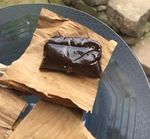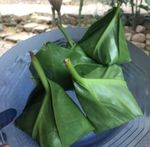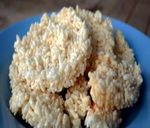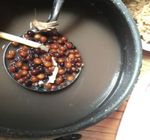Proximate Analysis of Some Local Food in Baduy Ethnic
←
→
Page content transcription
If your browser does not render page correctly, please read the page content below
Advances in Biological Sciences Research, volume 9
Joint proceedings of the 2nd and the 3rd International Conference on Food
Security Innovation (ICFSI 2018-2019)
Proximate Analysis of Some Local Food in Baduy
Ethnic
FitriaRiany Eris*, Aris Munandar, Kartina AM, Dian Anggraeni, Meutia, Taufik Hidayat, and
Dodi Hermawan
Agriculture Faculty
University of Sultan AgengTirtayasa
Indonesia Jalan Raya KM4 Pakupatan, Kota Serang, Banten
*fitria.eris@untirta.ac.id
Abstract – Baduy tribe is a tribe spreaded around Several tribes will choose the specific food
Banten Province. The most dominant ethnics group sources not only based on nutrients level, but also
has its own various food diversityin producing and considering the self-identity and the symbolic
creating food security in each small town. This study functions, values, and trust. Ethnical group of
aims to determine the proximate analysis of Baduy
people need to understand the concept of food
local food. There are various kinds of local food
processed in Baduy tribe society: Gipang, Tape, security. Every ethnics group has role in proposing
Wajik, Gemblong, Getuk Dangdeur, Uli, Rangginang, the opportunity, difficulty, and challenge in the
Wedang Jahe and Hiris nut Vegetable soup. This type process of food diversivication and food security.
of research is experimental research is a research The Baduy are one of the ethnic groups that up
laboratory that uses a simple experiment. At the to now still maintain the basic cultural values that
proximate analysis includes determination of they have and believe in, amidst the progress of
moisture content (%), protein content (%), Fat civilization around them. The Baduy tribe resides at
content, ash content (%), and crude fiber levels (%). the hillside of the Kendeng mountain range in the
The results showed that Wedang Jahe has highest of
village of Kanekes, Leuwidamar District, Lebak-
water content (93%), Rangginang showed highestof
protein content (7.19%) and fiber content (2.49), Uli Rangkasbitung Regency, Banten Province, located
showed highest of fat content (31,10%) and Getuk about 40 km from the city of Rangkasbitung.
has 1,49% of ash content. Region that is part of the Kendeng Mountains with
an altitude of 300 - 600 m above sea level (asl).
Keywords - Baduy tribe, local food, proximate The most dominant ethnics group has its own
analysis various food diversity, both food stuff and food
crops in each small town.
I. INTRODUCTION Some traditional Baduy foods that still use
Based on Indonesia constitution number 18, by traditional ingredients. The main ingredients of
the year 2012 (UU RI No.18/2012) about Food, it traditional Baduy food are rice, fish, and vegetables
is stated that many things concerning with food obtained from the surrounding environment. These
security system is organized by the constitutioan, foods are processed into processed foods such as
and the Province Governmenthas its own role to wajik, uli, ranginang, sticky rice tape, gipang,
create national food security. The province Getukdangdeur, GetukCauPanggalek, wedang
government has an important role since the system ginger, hiris vegetable soup, dodol. These
of food security is developed by the source of local processed foods are specially cooked using stoves
food in order to fulfill the needs of national food that use firewood. Exploration of local Baduy
security. The availability of local food sources in processed food is very important as a cultural
supporting the system of food security should be heritage. In exploring local processed foods, Baduy
optimized so that it can be consumed by society. ethnic groups need to know the nutritional value of
Indonesia is facing a big challenge in these foods. The lack of nutritional value contained
developing food security, because of cultural in food will have a negative impact on humans,
conception of food and varieties of ethnic or therefore it is necessary to provide additional
traditional food. It happens since the society or ingredients in order to improve the nutritional value
particular ethnics group has its own system and of Baduy processed foods. Therefore, it is
specific ecological system.The social cultural necessary to make an effort to determine the
system and ecology that they owned will create nutritional content of Baduy's processed foods
food security and specific nutrients which can be through proximate analysis.
learnt interestingly.
Copyright © 2021 The Authors. Published by Atlantis Press B.V.
This is an open access article distributed under the CC BY-NC 4.0 license -http://creativecommons.org/licenses/by-nc/4.0/. 6Advances in Biological Sciences Research, volume 9
II. RESEARCH METHOD tube, Durham tube, pipette, micropipette, incubator,
bunsen, erlenmeyer, measuring cup, autoclave, hot
A. Material
The materials used in this study are the basic plate, refrigerator, sealer, aluminum foil, spatula,
ingredients used in making Baduy ethnic processed meter, pH meter, texture analyzer, chromameter,
foods to make wajik (consisting of sticky rice, and reflux.
brown sugar and coconut), uli (sticky rice, coconut B. Stage of research
and salt), ranginang (glutinous rice, garlic and salt), The experiment was conducted by direct
sticky tape (glutinous rice, yeast, katuk leaves or observation of the process of making Baduy ethnic
suji leaves), gipang (sticky rice, sugar, water, processed food in the field and testing in the
cooking oil and sour water), dangdeurgetuk laboratory.The research begins with conducting
(cassava and salt), GetukCauPanggalek (horn and samples of processed foods (wajik, uli, rengginang,
salt banana ), gedang (ginger and palm sugar), taped rice, gipang, Getukdangdeur,
vegetable hiris (hiris, sugar and salt), dodol (brown GetukCauPanggalek, gedang ginger, vegetable
sugar, rice flour, coconut milk). In addition, hiris, and dodol). Proximate analysis was then
materials needed for proximate test, carried out to determine the content of protein, fat,
microbiological, physical and sensory analysis are ash, water, and carbohydrates.Protein analysis was
distilled water, 96% alcohol, sterile 0.85% NaCl done by using Kjedal semi-micro method, fat
solution, Plate Count Agar (PCA) media, Acidified analysis by using Soxlet method (SII 2453-90) and
Potato Dextrose Agar (APDA), Brilliant media. carbohydrate by using total carbohydrate by
Green Lactose Bile Broth (BGLBB), Eosin difference method.
Methylene Blue Agar (EMBA), spirits, tissue, pH 7
III. RESULT AND DISCUSSION
buffer, and saturated NaCl.
Tools used in the production of processed The results of baduy food processing are
Baduy ethnic food scales, basins, measuring cups, presented in figure 1, there were wajik, uli,
cups, stoves and knives. The tools for analysis are rengginang, taped rice, gipang, Getuk dangdeur,
aluminum cup, desiccator, oven, porcelain cup, Getuk Cau Panggalek, Wedang ginger, vegetable
furnace, stomacher, sterile petri dish, closed test hiris, and dodol.
Wajik Uli Rengginang taped rice
Gipang Getuk Dangdeur Cau Panggalek Wedang ginger
Vegetable hiris Dodol
Figure 1. Baduy processed foods.
7Advances in Biological Sciences Research, volume 9
TABLE I
THE PROXIMATE ANALYSIS OF BADUY ETHNIC PROCESSED FOODS
Water Ash Protein Fiber
Fat content
No Baduy processed foods content content content content
%
1 Gipang 6,83 0,32 22,76 3,74 1,64
2 Taped Rice 42,20 0,36 0,60 7,00 0,20
3 Dodol 28,28 0,62 6,21 3,31 0,81
4 Getuk Dangdeur 71,56 1,49 0,16 0,72 0,39
5 GetukCauPanggalek 50,97 0,78 0,38 2,00 0,26
6 Wajik 42,10 0,47 1,58 3,39 0,00
7 Uli 34,22 0,28 31,10 3,24 2,01
8 Rengginang 0,47 1,33 12.09 7,19 2,49
9 Wedang ginger 93,00 0,57 0,25 0,31 0,00
10 Vegetable Hiris 78,98 1,39 0,25 4,29 0,59
then add some salt. Mold the starch cassava as you
Baduy Processed foods that have been made, like.
then analyzed the nutritional content through Uli has the highest fat content (31.10%) and
proximate analysis. Nutrition content followed by Gipang (22,76%). The fat content is
measurements in this research included the content getuk dangdeur (0,16%). Although uli is made
of protein, fat, ash, water, and carbohydrates from sticky rice, uli has a high fat content, this is
percentage. The proximate analysis of Baduy because grated coconut is used in the processing.
processed foods is presented in table 1. The raw material for uli is white sticky rice mixed
The proximate analysis shows that Wedang with grated coconut and salt. The frying process
ginger shows the highest water content (93%) and also makes uli has a high fat content. The hot
followed by Getuk dangdeur with water content temperature when frying, makes the water content
71,56%. The lowest water content is produced by in the food disappear and the fat contained in the
Renginang(0,45%). Wedang Ginger is a special oil will enter to replace the position of water. This
drink of Baduy Tribe that made from Ginger. The absorbed fat causes foods that were low in calories
ingredientsof wedang ginger are ginger, brown to be high in calories. in addition, the use of
sugar, and hot water.Some of the active cooking oil during frying, causing the absorption of
components found in ginger are gingerol, shogaol, cooking oil which takes place during the frying
and zingeron which are included in the phenol process causes the fat content of the product to be
group. Gingerol, shogaol, and zingeron function as higher than the initial ingredients.
antioxidants, anti-inflammatory, anticancer, and One important physico-chemical parameter is
antifungal, so that consumption of ginger is highly protein. The availability of protein in the body is
recommended for health. very dependent on the composition of the food
Getuk Dangdeur has the highest ash content consumed by a person every day.Rengginang has
(1.49%) and followed by vegetable hiris (1,39%). the highest protein content and fiber content, which
The lowest ash content is uli (0,28%). Getuk are 7.19% and 2.49% respectively.
dangdeur is a special local food of Baduy that is Ethnic Baduy processed foods are known to be
served in special moments. The ingredients of high in carbohydrate content, but lack of protein
getuk dangdeur are Cassava and salt. The nutrient value. One of the efforts to fulfill the protein
content in 100 grams of cassava includes requirements for Ethnic Baduy processed food is to
Phosphorus 40.00 grams, Carbohydrates 34.00 consume fish through a diversification of
grams, Calcium 33.00 milligrams, Vitamin C 30.00 processing of fishery products, one of which is
milligrams, Proteins 1.20 grams, Iron 0.70 fortification. One alternative that can be used as an
milligrams, Fat 0, 30 grams and 0.01 milligrams of additional ingredient in increasing the nutritional
Vitamin B1. High phosphorus content causes getuk value of processed foods for ethnic Baduy is
dangdeur also has a high ash content compared to milkfish. Milkfish is a typical fish in Banten
other Baduy processed foods. [8] said that ash Province that is rich in nutritional value and
refers to the inorganic residue remaining after beneficial to human health, especially as a potential
either ignition or complete oxidation of organic protein producer. With the diversification effort of
matter in a food sample. Determining the ash milkfish, it is hoped that it can improve the
content of a food is part of proximate analysis for utilization of fisheries products and also increase
nutritional evaluation and it is an important the nutritional value added of Baduy processed
quality attribute for some food ingredients. There food.Efforts to fortify the nutritional value of
are some steps of making Getuk Cassava: first, peel processed foods typical of Baduy ethnic groups are
off the Cassava and then wash it. Steam the cassava expected to be able to provide benefits in
until it is done. Take out the steamed cassava, and improving Baduy Ethnic food security.
punch the steamed cassava until it becomes starch, Baduy local food products are processed
traditionally. Baduy local food products are faced
8Advances in Biological Sciences Research, volume 9
with a problem of non-uniformity in quality,
including the unevenness of taste, shape, color,
texture, and shelf life. Baduy local food products
are favored by the Baduy tribe has good prospects,
to be developed and commercialized. Factors that
influence the quality of Baduy local food products
include raw materials used, additional materials,
and processing technology.
IV. CONCLUSION
There are various kinds of local food processed
in Baduy tribe society: Gipang, Tape, Wajik,
Gemblong, Getuk Dangdeur, Uli, Rangginang,
Wedang Jahe and Hiris nut Vegetable soup. This
study shows that Wedang Jahe has highest of water
content (93%), Rangginang showed highest of
protein content (7.19%) and fiber content (2.49),
Uli showed highest of fat content (31,10%) and
Getuk has 1,49% of ash content. Baduy local food
has a high carbohydrate content so it needs to be
diversified to increase the nutritional value of
baduy local food products.
REFERENCES
[1] Aberoumand, A. (2012). Screening of phytochemical
compounds and toxic proteinaceous inhibitor in some
lesser-known food based plants and their effects and
AOAC (2005). Official Methods of Analysis (18th
edition) Association of Official Analytical, Chemists
International, Maryland, USA.
[2] Almatsier S. 2006. PrinsipDasarIlmuGizi. Jakarta: PT
Gramedia Pustaka Utama
[3] Brody, T. (1994). Nutritional Biochemistry, Academic
Press, San Diego, CA.
[4] Direktorat Gizi Departemen Kesehatan RI 1972. Daftar
Komposisi Bahan Makanan. Jakarta: Bhratara Karya
Aksara.
[5] Faridah DH, Kusnandar F, Herawati D, Kusumaningrum
HD and Wulandari N. 2008. Penuntun Praktikum Analisis
Pangan. Bogor: Departemen Ilmu dan Teknologi Pangan,
Fakultas Teknologi Pertanian, Institut Pertanian Bogor.
[6] Hariyadi RD. 2001. Peningkatan Peran Pusat Kajian
Makanan Tradisional dalam Rangka Penganekaragaman
Makanan: Kajian Proses Pengolahan, Khasiat dan
Keamanan Makanan Tradisional Jawa Barat. Laporan
Akhir. Pusat Kajian Makanan Tradisional. Bogor:
Lembaga Penelitian IPB.
[7] Haryadi 2006. Teknologi Pengolahan Beras. Yogyakarta:
Universitas Gadjah Mada.
[8] Ismail B.P. (2017) Ash Content Determination. In:
Food Analysis Laboratory Manual. Food Science Text
Series. Springer, Cham. (DOI:
https://doi.org/10.1007/978-3-319-44127-6_11).
[9] Lawless HT, Heyman H. 1998. Sensory Evaluation of
Food Principless and Practices. New York: Kluwer
Academic/Plenum Publishers
9You can also read

























































